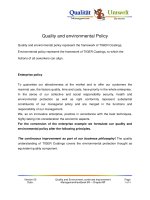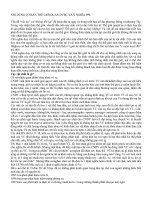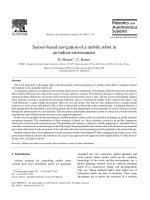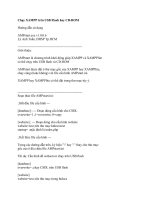Tài liệu Treason and the State docx
Bạn đang xem bản rút gọn của tài liệu. Xem và tải ngay bản đầy đủ của tài liệu tại đây (1.08 MB, 247 trang )
This page intentionally left blank
Treason and the State
This study traces the transition of treason from a personal crime against the monarch to a
modern crime against the impersonal state. It consists of four highly detailed case studies
of major state treason trials in England beginning with that of Thomas Wentworth, First
Earl of Strafford, in the spring of 1641 and ending with that of Charles Stuart, King of
England, in January 1649.
The book examines
how these trials constituted practical
contexts in which ideas of
statehood and public authority legitimated courses of political action that might ordi-
narily be considered unlawful – or at least not within the compass of the foundational
statute of 25 Edward III. The ensuing narrative reveals how the events of the 1640s
in England challenged existing conceptions of treason as a personal crime against the
king, his family and his servants, and pushed the ascendant parliamentarian faction
toward embracing an impersonal conception of the state that perceived public authority as
completely independent of any individual or group.
d. alan orr was educated at Queen’s University at Kingston, the University of Glasgow
and the University of Cambridge, where he received his Ph.D. in 1997. He has taught
subsequently at Carleton University in Ottawa and Queen’s University at Kingston.
Cambridge Studies in Early Modern British History
Series editors
anthony fletcher
Victoria County History, Institute of Historical Research, University of London
john guy
Professor of Modern History, University of St. Andrews
and john morrill
Professor of British and Irish History, University of Cambridge,
and Vice-Master of Selwyn College
This is a series of monographs
and studies covering many aspects
of the history of the
British Isles between the late fifteenth century and the early eighteenth century. It
includes the work of established scholars and pioneering work by a new generation of
scholars. It includes both reviews and revisions of major topics and books, which open
up new historical terrain or which reveal startling new perspectives on familiar subjects.
All the volumes set detailed research into our broader perspectives and the books are
intended for the use of students as well as of their teachers.
For a list of titles in the series, see end of book.
TREASON AND
THE STATE
Law, Politics, and Ideology in the
English Civil War
D. ALAN ORR
Cambridge, New York, Melbourne, Madrid, Cape Town, Singapore, São Paulo
Cambridge University Press
The Edinburgh Building, Cambridge , United Kingdom
First published in print format
ISBN-13 978-0-521-77102-3 hardback
ISBN-13 978-0-511-06879-9 eBook (EBL)
© D. Alan Orr 2002
2002
Information on this title: www.cambrid
g
e.or
g
/9780521771023
This book is in copyright. Subject to statutory exception and to the provision of
relevant collective licensing agreements, no reproduction of any part may take place
without the written permission of Cambridge University Press.
ISBN-10 0-511-06879-4 eBook (EBL)
ISBN-10 0-521-77102-1 hardback
Cambridge University Press has no responsibility for the persistence or accuracy of
s for external or third-party internet websites referred to in this book, and does not
guarantee that any content on such websites is, or will remain, accurate or appropriate.
Published in the United States by Cambridge University Press, New York
www.cambridge.org
CONTENTS
Acknowledgmentspageix
List of abbreviations xi
Introduction 1
Part I: Concepts
1 The statutory basis of English
treason law 11
2 Sovereignty and state 30
Part II: Practice
3 Thomas Wentworth, First Earl of Strafford 61
4 William Laud, Archbishop of Canterbury 101
5 Connor Lord Maguire, Second Baron of Enniskillen 141
6 Charles Stuart, King of England 171
Conclusion 206
Bibliography 211
Index 224
vii
ACKNOWLEDGMENTS
An older and wiser friend once remarked to me that many projects of histor-
ical research begin serendipitously – a chance curiosity growing into some-
thing larger, more involved, and more substantive over a lengthy period of
time. At the time I greeted this statement with great skepticism;
however,
I now realize that it is usually true more often than not. This book is a result
of
one of those chance curiosities demanding further exploration.
In this process of exploration there are many people who have helped
along the
way. John Morrill supervised the Cambridge doctoral dissertation
from which this book derives and continued to believe in it even when I was
not sure that I did. My examiners Glenn Burgess and
Conrad Russell made
a potentially difficult and intimidating process not only enjoyable but also
highly instructive and stimulating. William Davies at Cambridge University
Press has been an exemplar of patience with yet another late manuscript.
Wallace MacCaffrey, Alan Cromartie, David Smith, Paul Bradbury, and Phil
Withington read and commented on the manuscript at various stages of
its evolution and provided invaluable input. During my time at Cambridge
I was fortunate to be surrounded by a lively and supportive circle working in
the early modern period
including Oleg Roslak, Geoff Baldwin, Tony Nuspl,
Craig Muldrew, Patrick Carter
, Jurgen Overhoff, Mark Perrott, Phil Baker,
Elliot Vernon, Phil West, Mary Morrissey
, Nicola Perkins, Katie Craik, Neil
Reynolds, Eamonn O’Ciardha, Doron Zimmerman, and Neel Mukherjee.
A special thankyou goes also to Adam Slater, Steve Hudson, Hugo Azerad,
and Larry Small.
I would like also to thank the staff of the Cambridge University Library
Rare Books and Manuscripts Rooms as well as David De Lorenzo of the
Harvard Law School Library, who was extremely helpful during a short
visit in 1997. I am also grateful to the Social Sciences and Humanities
Research Council of Canada, the Cambridge Commonwealth Trust,
and
Selwyn College Cambridge for providing generous financial assistance at
various stages. Most of chapter 5 of this book appeared as part of a slightly
lengthier article in the Journal of British Studies 39 (2000) titled “England,
ix
x Acknowledgments
Ireland, Magna Carta, and the Common Law: The Case of Connor Lord
Maguire, 2nd Baron of Enniskillen.” I would like to extend my gratitude to
the University of Chicago Press for granting permission to reprint a revised
version of that article as part of this study.
My final thankyou goes to my parents, Don and Carrole Orr, for patiently
indulging these serendipitous curiosities that have preoccupied me so much
in recent years. Without them all this would be impossible.
ABBREVIATIONS
AHR American Historical Review
AJLH American Journal of Legal History
Anderson Named Reporter contained in the
English Reports
BL Harl. British Library, Harleian MSS
BL Sloane British Library, Sloane MSS
BL TT British Library, Thomason Tracts
Bodl. Lib. Tanner Bodleian Library, Tanner MSS
CJ Journal of the House of Commons
Coke, Reports The Reports of Sir Edward Coke, knt.
In thirteen parts. 6 vols. John Henry Thomas
and John Farquhar Fraser, eds. London, 1826
DNB Dictionary of National Biography
Dyer Named Reporter contained in the English
Reports
EHR English Historical Review
Eng. Rep. English Reports. London, serial
HJ Historical Journal
HLQ Huntingdon Library Quarterly
HLS Harvard Law School MSS
HMC Lords XI HMC House of Lords, The Manuscripts of The
House of Lords, Addenda 1514–1714. vol. XI,
new series, ed. Maurice F. Bond, London, 1962
HPT History of Political Thought
IHS Irish Historical Studies
Irish Statutes W. Ball ed., The Statutes at Large passed in
the Parliaments held in Ireland,20vols.
Dublin 1784–1801.
IT Petyt Inner Temple, Petyt MSS
JBS Journal of British Studies
JEH Journal of Ecclesiastical History
xi
xii List of abbreviations
JLH Journal of Legal History
LJ Journal of the House of Lords
LQR Law Quarterly Review
MM Manuscript Minutes of the House of Lords
New DNB New Dictionary of National Biography
P&P Past and Present
PRO SP Public Record Office, State Papers
SL
The Statutes at Large
,
18 vols. London 1763
–1800
SR The Statutes of the Realm, 11 vols. Reprinted
London, 1963
State Trials Cobbett W. and Howell T. B. et al., eds., A Complete
Collection of State Trials. 33 vols. London,
1809–1826
WC Clarke Worcester College Oxford, Clarke MSS
Works The Works of the most reverend father in God
William Laud, D.D. sometime Lord Archbishop
of Canterbury, ed. J. Bliss and W. Scott, 7 vols.
Oxford, 1847–1860
Introduction
Today we frequently presume that treason is first and foremost a crime
against “the state.” This was not always the case. The law of treason in
England was at the time of its statutory declaration in 1352 as much a per-
sonal crime against the monarch as the unlawful usurpation of his sovereign
authority. Compassing the death of the monarch and his heir apparent was
arguably more heinously treasonable than forging his seal and issuing false
charters in his name. However, during the late medieval and early modern
periods new demands emerged. The English law of treason became the prin-
cipal means of enforcing not only new religious policies in England and
Wales but also self-consciously “imperial” policies in the newly created
Kingdom of Ireland. In the century before Britain’s civil wars of the mid-
seventeenth century, developments including the Reformation under Henry
VIII, the extension of English control over the whole of Ireland, and the
spread of the Counter-Reformation had already imposed unprecedented de-
mands on the law of treason. However, the dramatic events of the civil wars
of the 1640s culminating in the trial and execution of King Charles I for high
treason in 1649 and the establishment of a “Commonwealth or Free State”
in place of the monarchy constituted, unquestionably, the greatest challenge
to the existing English law of treason.
Debate on the English law of treason in the early modern period has
focused primarily on questions of legality: what actions constituted trea-
son under the existing statute law? However, a failure to interpret the key
treason statutes in their ideological contexts has given rise to an unfortunate
tendency of “retrying” treason trials according to anachronistic standards of
construction.
1
In a modern court of law no crime is deemed to have occurred
unless the actions of the accused fall strictly within the relevant statute. When
there is doubt whether the relevant statute applies, the case is always to be de-
cided in favor of the accused. Relying on this kind of thinking, some scholars
1
T. G. Barnes, review of Tudor Law of Treason: An Introduction, by J. G. Bellamy, AHR 85
(1980): 1190–1191.
1
2 Treason and the State
have made pronouncements as to the “guilt” or “innocence” of particular
persons accused of treason without adequate examination of the role played
by commonly held political ideas in the events of these trials.
2
Concomitantly,
the law of treason’s broader roles in not only the formation of a centralized
English state but also in the English imperial enterprise in Ireland and the be-
ginnings of empire have received short shrift. State treason trials provide
the opportunity to examine not only the historical evolution of a particular
body of law, but also the usage
and deployment of a broader range
of political
and juristic concepts relating to kingship and statehood. Historically speak-
ing, questions of “legality” are not fruitfully discussed or answered without
some explanation as to
how the law of treason related to the history of po-
litical ideas and the often haphazard process of early modern state building.
The failure to give adequate consideration to the role of “constructive”
treasons is symptomatic of this unfortunate tendency. The foundational
statute of 1352 defined treason as crimes against the king, his family and
his servants; however, this did not necessarily entail an allegiance-derived
understanding of the English polity based only on oaths of fealty to a single
individual. As J. H. Baker has noted: “In early societies there is no concept of
the ‘state’. Both compensation and retribution for wrongdoing are exacted
at the instance of the wronged individual and his kin.”
3
England on the
eve of the first Civil War was no longer such a society and had not been
for some time. The law of treason was inextricably bound up with contem-
porary ideological debates concerning the nature of sovereignty and what
was increasingly denoted as “the state.”
4
Treason was not simply a crime
against the king’s natural person or a breach of allegiance but had increas-
ingly become the unlawful seizure of sovereign or state power.
5
It was a
crime against the king not merely in respect of his person but in his role as
the lawful wielder and guardian of sovereign power.
2
An example of this failing is W. R. Stacy’s treatment of the attainder of the Earl of Strafford.
Stacy condemns the theory of treason in the trial of Strafford as “an unprecedented theory
of accumulative treason” without having seriously examined the arguments presented with
regard to their relationship to the available political vocabularies. Instead his conclusions
derive from a narrow and ultimately anachronistic legalism: W. R. Stacy, “Matter of Fact,
Matter of Law, and the Attainder of the Earl of Strafford,” AJLH 29 (1985): 324.
3
J. H. Baker, An Introduction to English Legal History, 3rd edn. (London, 1990), p. 571.
4
Quentin Skinner, “The State,” in Terence Ball et al., eds., Political Innovation and Conceptual
Change (Cambridge, 1989), pp. 90–131; Quentin Skinner, Foundations of Modern Political
Thought, vol. I: The Renaissance (Cambridge, 1977), Preface, pp. ix–x; Quentin Skinner,
Liberty Before Liberalism (Cambridge, 1998), pp. 4–5.
5
J. A. C. Thomas has made this argument with respect to the Roman law of treason, albeit
it should be emphasized here that the concepts of “state” and “sovereignty” as they are
discussed here are very much products of the late sixteenth and early seventeenth century:
J. A. C. Thomas, ed. and trans., The Institutes of Justinian: Text, Translation and Commentary
(Cape Town, Wynberg and Johannesburg, 1975), p. 335.
Introduction 3
The notion of sovereignty was itself problematic. Early modern jurists
and political thinkers were still struggling with the concept. “Sovereignty”
in common usage was not necessarily a single arbitrary power of command,
but a cluster of powers relating to the practical governance of the realm.
These commonly encompassed, for example, the power to give law, levy
war, make peace, appoint magistrates, and mint coin. However, the concept
was, when carried into the realm of political practice, heavily contested. For
example, did it include power to determine the doctrine and discipline of
the established church? If so, how was this power exercised: through the
king-in-parliament, through the king and the clerical estate assembled in
convocation, or through the king alone in a purely personal capacity? At
issue was not simply the relationship between subject and sovereign, ruler
and ruled, but the very definition of the concept itself.
The English law of treason on the eve of the Civil War was a body of
principles as much in keeping with Roman law notions
of treason as with
feudal or Germanic conceptions of treason. While the latter conceived of
treason as a breach of faith or fidelity to one’s feudal superior, the former
saw crimen maiestatis – crimes of majesty or sovereignty in the lexicon of
the
period
6
– as, in the words of S. H. Cuttler, “an act or plot the goal of
which was to diminish the greatness
or security of the sovereign power
”
that was also “tinged with sacrilege.”
7
This did not entail the discarding of
existing treason legislation but simply the reinterpretation of treason statutes
according to more current ideological assumptions and political realities. In
1641 the concept of kingship could mean either the office or public capacity
of the monarch as head of state or their private person. Indeed, the received
constitutional orthodoxy in the years after the accession of James VI of
Scotland to the English throne in 1603 was that the two were inseparable.
Accordingly, treason was a crime against both the monarch and his or her
regal estate by virtue of their lawful possession of sovereign power. The
actions of a traitor encompassed those that tended toward the unlawful
appropriation of the authority of the state to their own private use. Only
when viewed in this context will questions concerning the “legality” and
legitimacy of key English state treason trials during the Civil War receive
adequate consideration.
This study contends that in public law terms the early modern state was
essentially a corporate body – a juristic person consisting of ruler and ruled
bound together by the rule of law. This rule of law was “fundamental” to
the constitution of the polity as a corporate body. In this particular instance
6
“Maiestas” was translated as both “sovereignty” and “majesty” in the early modern period.
7
S. H. Cuttler, The Law of Treason and Treason Trials in Later Medieval France (Cambridge,
1981), p. 6.
4 Treason and the State
that law was the municipal law of England, the common law. The common
law was in this sense “fundamental” to the constitution of the English and
by extension the Irish polities.
8
However, within this corporation the rela-
tionship of ruler and ruled, church and polity, was becoming problematic
with the traditional framework of the king’s two bodies coming increas-
ingly under strain.
9
According to the commonplace notion of the king’s two
bodies advanced in the writings of jurists such as Plowden and Coke the
state was not a fully impersonal political entity. When the king acted in his
political capacity he acted as a corporation yet his political
body, his
“state,”
remained inextricably bound up with his body natural and the heirs of his
body. As Marie Axton has noted, late Tudor and early Stuart jurists “were
formulating an idea of the state as a perpetual corporation, yet they were
unable or unwilling to separate state and monarch.”
10
The kingdom was
more of the nature of a corporation entailed to a particular family than a
purely abstract or impersonal entity.
However, the potential for such a separation did exist. For example, the
Huguenot author of the Vindiciae Contra Tyrannos had, as early as the
1570s, argued that it was the people not the king that formed a perpet-
ual corporate body.
11
Furthermore, while not calling for the supplanting of
monarchy with a popular corporate republic, this author also suggested
that
a monarch who committed a felony against the people could be adjudged
guilty of high treason.
12
In 1641 the English law of treason, statutorily de-
fined as compassing or imagining the death of the king, depended on the
inseparability of the king’s corporate public authority from his or her nat-
ural person. Crimes against the political body of the whole state were also
necessarily crimes against the king’s natural body. The events of the civil
wars of the 1640s and ultimately in 1649 the ideological demands of regi-
cide led to the appropriation of a fully impersonal conception of the state in
which the king, acting beyond his commission as an inferior magistrate, had
derogated from the sovereign authority of the people.
8
The concept of “leges imperii,” or “fundamental laws” in late medieval and early modern
usage pertains to the received laws of a particular realm as opposed to natural law
(lex naturalis) or the law of nations (ius gentium), both of which applied to all peoples
and all realms; I would like to extend my thanks to Mr. Robert Moody for clarifying this
point. See also chapter 2, below.
9
Michael Mendle, “Politics and Political Thought, 1640–42,” in Conrad Russell, ed., The
Origins of the English Civil War (London, 1973), p. 221.
10
Marie Axton, The Queen’s Two Bodies: Drama and the Elizabethan Succession (London,
1977), p. 12.
11
Stephanus Junius Brutus [Philippe Mornay? Hubert Languet?], Vindiciae, Contra Tyrannos:
or concerning the legitimate power of a prince over the people, and of the people over a
prince, ed. and trans. George Garnett (Cambridge, 1994), pp. xxiii, 90; see also chapter 6,
below.
12
Brutus, Vindiciae, Contra Tyrannos, p. 156.
Introduction 5
In the 1640s and 50s events drove ideas. Although republican modes of
civic consciousness undoubtedly had some presence before the conflagra-
tions of the 1640s England was, at least in theory, a monarchical state.
13
“Revolutionary” political thinking, such as one might attribute to the likes of
Hobbes, Milton, Sidney, or Harrington, was the fruit of this era not its
cause.
14
By contrast the ideas deployed in the context of state treason trials
were of necessity familiar, commonplace, sometimes even disappointingly ba-
nal. They were, after all, explicitly “ideological” – political actors used them
to redescribe a particular set of actions as “good,” “legal,” and “moral”
with an eye to convincing the faint-hearted, the undecided, and the uncom-
mitted. In order for them to have purchase with their intended audiences
they were of necessity familiar and appealed to shared values and shared
authorities. Nevertheless, they are very important because they demonstrate
that the link between political thought and political practice was far from
seamless in early modern Britain.
Quentin Skinner has emphasized the
inseparable relationship of political
thought to political action.
15
This study does not
dispute this contention
but rather accepts it as given. It does, however, offer qualification and re-
finement. The context of a trial and the setting of a court of law, like any
institutional context, privilege certain sources, texts, ideas, and rhetorics
over others. For example, even before
the Long Parliament ordered that the
remaining writings of Sir Edward Coke be published, his writings already
enjoyed something of a quasi-canonical status. Sir John Davies was a former
Chief Justice of England (however briefly) and his writings were accordingly
afforded a similar status, particularly with respect to Ireland where he served
as Attorney-General. In the absence of official reporting the good reputation
13
J. G. A. Pocock has argued that before the 1640s the predominant mode of civic conscious-
ness in England was that of territorial and jurisdictional monarchy and that civic human-
ism with its attendant values of active citizenship became a force only after that period:
J. G. A. Pocock, The Machiavellian Moment: Florentine Political Thought and the Atlantic
Republican Tradition (Princeton, 1975), chapter 10. This thesis has been challenged
by Patrick Collinson and more recently Markku Peltonen: Markku Peltonen, Classical
Humanism and Republicanism in English Political Thought, 1570–1640 (Cambridge, 1995);
Patrick Collinson, “The Monarchical Republic of Elizabeth I,” Bulletin of the John Rylands
Library 69 (1987): 394–424.
14
Jonathan Scott, “The English Republican Imagination,” in J. S. Morrill, ed., Revolution
and Restoration: England in the 1650s (London, 1992), pp. 35–54; Blair Worden, “English
Republicanism,” in J. H. Burns and M. Goldie, eds., The Cambridge History of Political
Thought, 1450–1700 (Cambridge, 1991), pp. 443–475; Blair Worden, “Classical Republi-
canism and the Puritan Revolution,” in Hugh Lloyd-Jones, Valerie Pearl, and Blair Worden,
eds., History and Imagination: Essays in Honour of H. R. Trevor-Roper (London, 1981),
pp. 182–200.
15
Quentin Skinner, “The Principles and Practice of Opposition: The Case of Bolingbroke versus
Walpole,” in Neil McKendrick, ed., Historical Perspectives: Studies in English Thought and
Society in Honour of J. H. Plumb (London, 1974), pp. 93–128.
6 Treason and the State
of the author or the antiquity of a source became crucial in determining its
relative validity and the forensic rhetoric of the day placed a premium on
this. For example, the king’s two bodies was an important political concept
not simply because it was omnipresently there among an amorphous com-
mon stock of concepts, but because it received authoritative definition in
Coke’s report of Calvin’s Case in the seventh part of his Reports. Citation
of a prominent and recognized authority was an accepted, effective strat-
egy in achieving practical political objectives. As a consequence, attempts
to liberate us from the grip of law-centered political thought in the anal-
ysis of seventeenth-century political language and culture require careful
reconsideration.
16
This book is structured in two parts of two and four chapters respectively.
The first chapter will discuss the growth of English treason legislation in the
early modern period and its response to the demands of the Reformation, the
extension of English control over the whole of Ireland, and the rise of Jesuit
and missionary priest activity in the last quarter of the sixteenth century. In
broader terms the law responded to three pressures: Protestant Reformation,
Catholic Reformation, and the beginnings of British imperialism in Ireland.
The second chapter will establish the ideological context in which the law
of treason operated at the opening of the Civil War by establishing working
definitions of the terms “sovereignty” and “state.” Key themes here will be
the development of the theory of the king’s two bodies, the growth of the
idea of an impersonal or abstract “state” in early modern political thought,
and their respective roles in the interpretation of English treason law. The
chapter will offer a concept of sovereignty as a practical cluster of positive or
“state” powers that political actors contested with competing and alternately
shared rhetorics. While the revisionism of the 1970s threatened to banish the
concept of sovereignty from the debate on the origins of the English Civil War,
the goal here is to reposition the concept of sovereignty at the center of that
debate without recourse to older whiggish narratives of absolutism versus
constutionalism.
17
The English Civil War was a struggle for sovereignty but
it was not a struggle driven by rival accounts of the locus of sovereign power,
king or people, ascending or descending – it was a struggle for definition.
Deep ideological polarities were the legacy not the cause of these events.
The four chapters of part II consist of four detailed case studies of major
English state treason trials. The first is that of Thomas Wentworth, First Earl
16
Alan Cromartie has emphasized this point in his recent discussion of Harrington: Alan
Cromartie, “Harringtonian Virtue: Harrington, Machiavelli, and the Method of the
Moment,” HJ 41 (1998): 1008–1009.
17
The work of Johann Sommerville springs to mind here: Johann Sommerville, Politics and
Ideology in England, 1603–1640 (London, 1986); for a contrasting view see Kevin Sharpe,
Politics and Ideas in Early Stuart England: Essays and Studies (London, 1989), pp. 286–287.
Introduction 7
of Strafford, in March, April, and May 1641, followed by those of William
Laud, Archbishop of Canterbury, over the course of 1644, Connor Maguire,
Second Baron of Enniskillen, in early 1645, and concluding with that of
Charles Stuart, King of England, in January 1649. The trial of Wentworth for
his role in Charles I’s personal rule of the 1630s in both England and Ireland
was arguably the most controversial English state treason trial of the Stuart
era. No study of the law of treason in the Civil War can go forward without
giving it adequate consideration. Laud’s trial, while receiving less attention
from historians, concerned the disputed relationship of church and state
and, more particularly, competing conceptions of the supremacy, Erastian
and clerical. The trial of Maguire, an Irish peer tried in England for treason
committed in Ireland, raised questions involving sovereignty and allegiance
in a composite state or multiple monarchy. More specifically, it also raised
questions concerning the constitutional relationship of England and Ireland:
separate kingdoms united by a shared personal
allegiance and rule of law
yet divided by departures in the practice of government and the need for
a shared
sense of antiquity. If the trial of the king in January 1649
and his
concomitant reduction from the lawful holder of sovereign power to the role
of inferior magistrate in a popular state was less controversial than
that of
Strafford, it was only because it was so much more clearly illegal. It was an
unprecedented
event that no study of this kind can afford to ignore.
Treason and the State is not, therefore, an attempt at comprehensively
retelling the story of the English law of treason during the middle of the
seventeenth century. It is rather an examination of four occasions of state as
ideological events in which both competing and alternately shared concep-
tions of public authority found expression as political practice. While the
selection of only four trials may seem limiting, it must be remembered that
two of these trials have already formed the basis of monographs.
18
Indeed,
a full consideration of all aspects
of any one of these trials could on its own
easily form the foundation
for a book-length study. The criteria by which the
four trials were selected are their relative significance in constitutional terms
and the availability of source material, the latter making them something of
a self-selecting sample.
18
J. H. Timmis III, Thine is the Kingdom: The Trial for Treason of Thomas Lord Wentworth,
Earl of Strafford, First Minister to King Charles I and Last Hope of the English Crown
(Tuscaloosa, Ala., 1974), and C. V. Wedgwood, The Trial of Charles I (Glasgow, 1964;
reprinted Harmondsworth, 1983).
Part I
CONCEPTS









